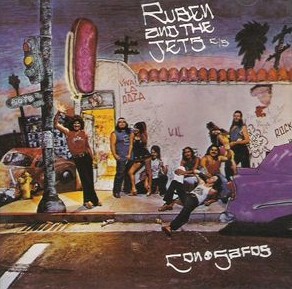Rubén “Funkahuatl” Guevara took on many personas as he developed his musical career, which reflects the many different ideas about Chicano identity that circulated throughout pop culture during the 60s and 70s, as well as the transformation of Chicano representation in music with the beginning of the Chicano Movement. Rubén in particular brings up an interesting conversation about commercialism, and how in his case used it to spread an image of Chicano presence in American music beginning with “doo-wop”, a variation of blues and rock and roll, especially as he began performing on television shows. Shindig! was a variety show that aired from 1964 to 1966, in which he performed with artists such as Bo Diddley, Tina Turner, and other African American blues artists. In order to be on the show, Rubén had to incorporate a stage name, Jay P. Mobey, which you can see in the video below:
 The changing of his name from Rubén Guevara to Jay P. Mobey suppressed his identity as an Mexican-American on the stage, and when the show ended in 1966 he sought to re-invent himself as Chicano, and began singing with Frank Zappa in Ruben and the Jets. With this group as well, he blended with the sounds of the time, now immersing himself in the R&B and rock of the 70s. In 1974, Ruben and the Jets released an album called “Con Safos.” Con Safos means “with safety,” and was a tag that was written on the graffiti throughout Los Angeles to indicate to others not to cover their work. This album cover positions Guevara in the center of the picture, with depictions of artists outside of a liquor store in L.A. “Viva la Raza” is written on the wall, a phrase used during the Chicano movement to signify their reclamation of Chicano heritage, culture, language and race. Guevara’s music once again blends with similar sounds of the period, this time rock and roll, but uses his avenue as a popular artist to promote Chicano presence in the music scene.
The changing of his name from Rubén Guevara to Jay P. Mobey suppressed his identity as an Mexican-American on the stage, and when the show ended in 1966 he sought to re-invent himself as Chicano, and began singing with Frank Zappa in Ruben and the Jets. With this group as well, he blended with the sounds of the time, now immersing himself in the R&B and rock of the 70s. In 1974, Ruben and the Jets released an album called “Con Safos.” Con Safos means “with safety,” and was a tag that was written on the graffiti throughout Los Angeles to indicate to others not to cover their work. This album cover positions Guevara in the center of the picture, with depictions of artists outside of a liquor store in L.A. “Viva la Raza” is written on the wall, a phrase used during the Chicano movement to signify their reclamation of Chicano heritage, culture, language and race. Guevara’s music once again blends with similar sounds of the period, this time rock and roll, but uses his avenue as a popular artist to promote Chicano presence in the music scene.
Finally, it is interesting to see such a radical change in sound and image as he went through his life and musical career. After Ruben and the Jets dispersed, Rubén recorded a song called “C/S” with a group called Con Safos, which explicitly discusses the Vietman War, and prejudice against Chicanos and their reclamation of their heritage. This song was published in 1983 in an LP called “The Eastside Renaissance.”
I encourage you to listen to all three of these stages of Ruben’s career and journey with his Chicano identity. Rubén’s adaptability to popular genre could be perceived as un-original or commercial, but I think it ultimately represents the journey that many Mexican-Americans experienced throughout the Chicano movement in terms of establishing and celebrating their identity and culture in the United States.
It is important to note that it wasn’t until the beginning of the Chicano movement that “chicano” was an appropriate word to describe Americans of Mexican descent. Chicano comes from the Nahuatl word xicano, which represents the reclamation of indigenous heritage of the Mexica peoples, who lived in the southwest region of present day United States.
